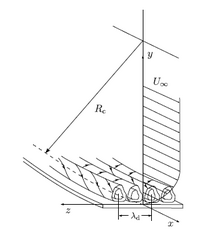In fluid dynamics, Görtler vortices are secondary flows that appear in a boundary layer flow along a concave wall. If the boundary layer is thin compared to the radius of curvature of the wall, the pressure remains constant across the boundary layer. On the other hand, if the boundary layer thickness is comparable to the radius of curvature, the centrifugal action creates a pressure variation across the boundary layer. This leads to the centrifugal instability (Görtler instability) of the boundary layer and consequent formation of Görtler vortices.

Görtler number
editThe onset of Görtler vortices can be predicted using the dimensionless number called Görtler number (G). It is the ratio of centrifugal effects to the viscous effects in the boundary layer and is defined as
where
- = external velocity
- = momentum thickness
- = kinematic viscosity
- = radius of curvature of the wall
Görtler instability occurs when G exceeds about 0.3.
Other instances
editA similar phenomenon arising from the same centrifugal action is sometimes observed in rotational flows which do not follow a curved wall, such as the rib vortices seen in the wakes of cylinders[1] and generated behind moving structures.[2]
References
edit- ^ Williamson, C. H. K. (1996). "Vortex dynamics in the cylinder wake". Annual Review of Fluid Mechanics. 28: 477–539. Bibcode:1996AnRFM..28..477W. doi:10.1146/annurev.fl.28.010196.002401. Archived from the original on 2022-06-16. Retrieved 2020-06-23.
- ^ Buchner, A. J.; Honnery, D.; Soria, J. (2017). "Stability and three-dimensional evolution of a transitional dynamic stall vortex". Journal of Fluid Mechanics. 823: 166–197. Bibcode:2017JFM...823..166B. doi:10.1017/jfm.2017.305. S2CID 125937677. Archived from the original on 7 November 2017. Retrieved 2 November 2017.
- Görtler, H. (1955). "Dreidimensionales zur Stabilitätstheorie laminarer Grenzschichten". Journal of Applied Mathematics and Mechanics. 35 (9–10): 362–363. Bibcode:1955ZaMM...35..360.. doi:10.1002/zamm.19550350906.
- Saric, W. S. (1994). "Görtler vortices". Annu. Rev. Fluid Mech. 26: 379–409. Bibcode:1994AnRFM..26..379S. doi:10.1146/annurev.fl.26.010194.002115.